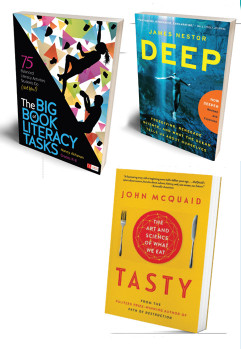Book Review: THE BIG BOOK OF LITERACY TASKS
THE BIG BOOK OF LITERACY TASKS: 75 BALANCED LITERACY ACTIVITIES STUDENTS DO (NOT YOU!)
Nancy Akhavan (Corwin Literacy)
Nancy Akhavan has a simple philosophy: learning happens when students, not the teachers, are doing the work. Social cognitive theory supports the notion that students can learn from watching someone else perform a task. However, the theory also supports the idea that students learn more when they are directly involved in the activity and the task is just challenging enough to sustain their interest and desire to work.
This is expressed in the ‘I Do, We Do, You Do’ responsibility model. It encourages teachers to focus intentionally on modelling during the I Do phase. Next, students are engaged with different types of collaboration during the We Do phase. Finally, teachers coach students during the You Do phase.
That is the premise of Akhavan’s book The Big Book of Literacy Tasks: 75 Balanced Literacy Activities Students Do (Not You!), which provides research-based ideas for developing readers and writers in grades K-8. It does not provide an explicit lesson plan, but rather a collection of strategies that good readers and writers use to develop their own connections and ideas.
Akhavan – an Assistant Professor in the Department of Educational Research and Administration at California State University, Fresno – knows her subject matter. Previously, she was Assistant Superintendent of School Leadership for Middle Schools in Fresno Unified School District, a large urban district in California’s Central Valley. Akhavan has worked as a district staff developer, principal, elementary school bilingual teacher, bilingual resource teacher, and professional development coordinator for over 20 years.
Passionate about providing a high-quality education for all children through authentic, purposeful instruction, Akhavan has provided staff development training to teachers (grades K-12) on topics such as literacy, vocabulary development, writing, English language development, standards-based instruction, coaching and leadership. She has also provided training to teacher leaders and administrators in systems and culture change, school reform, and classroombased professional development.
In addition to her work in classrooms and schools, Akhavan has written eight books including Teaching Writing in a Title I School, K-3; Help! All My Students Don’t Speak English: How to Set Up a Language Workshop in Your Linguistically Diverse Classroom; and How to Align Literacy Instruction, Assessment, and Standards and Achieve Results You Never Dreamed Possible.
The Big Book of Literacy Tasks: 75 Balanced Literacy Activities Students Do (Not You!) consists of three sections – Everyday Tasks, Weekly Tasks and Sometimes Tasks for reading, writing and thinking – that ref lect the ‘I Do, We Do, You Do’ responsibility model.
The Everyday Tasks are 35 activities designed to build skills that good readers and writers use each and every time they read and write. These tasks help students make connections, learn to read and write with purpose, and most importantly, think about reading and writing. Included in this section are tasks for developing focus, using details to support comprehension, and collaborating with peers.
Next, Akhavan provides 14 Weekly Tasks that are more specific and take more time for students to complete. These tasks involve use of more complex texts in reading and more specific output requirements for writing assignments. The skills presented in this section include creating an outline, organizing research, sharing writing with an audience, and writing a book report.
The Sometimes Tasks are the most demanding tasks in the book. These tasks require more student thinking and a deeper dig into the literacy experience. They invite students to make connections between texts, to use peer-to-peer analysis, to think aloud, and to critique the validity of a text.
The Big Book of Literacy Tasks also contains reproducible forms. However, rather than posing questions related directly to a piece of writing, Akhavan gives teachers checklists that encourage student thinking and ref lection. These forms include Conversations About the Texts, My Strategies for Independence, Checking My Understanding, Making Connections, and Identifying the Central Idea.
Akhavan stresses that during the I Do phase teachers must be transparent in their thinking and need to pause to talk students through what was done and why.
Collaboration is central to the We Do phase. It simply means that all people involved in the task are making meaningful contributions to the work. This includes students working together while the teacher provides support and helps students discover ideas and answers for themselves.
The You Do phase is about practice. Learners need you to provide feedback immediately if they are developing misconceptions to prevent frustration. To foster maximum engagement, teachers need to provide as much student voice and choice as possible.
Akhavan is unf linching in her belief that great tasks are not teacher directed and are not focused on teacher-pleasing mindsets. Great tasks are activities where students have the greatest degree of ownership and choice as possible. Teachers are the facilitators of the work or tasks, and when students are involved in that, they engage at maximum levels.
The great thing about The B ig Book o f Literacy Tasks is that it offers an instructional plan designed to yield independent effort and engagement. The 75 tasks are concisely and attractively presented in full colour and move more swiftly than many of its contemporaries from the I Do teacher phase to the You Do student phase.
The most important take-way from The Big Book of Literacy Tasks is that it offers learning facilitators the opportunity to reflect on their own roles in the teaching process, while providing a clear framework for “working the minds” of students to help them forge their own path to becoming better readers and writers.
DEEP: FREEDIVING, RENEGADE SCIENCE, AND
WHAT THE OCEAN TELLS US ABOUT OURSELVES
James Nestor (Eamon Dolan)
Divers know of an underwater region called the doorway to the deep, and author James Nestor swings it open with this book, which began simply enough with a magazine assignment to cover a freediving competition held in Greece.
In the most extreme-of-extreme sports, participants plunge hundreds of feet below sea level without oxygen tanks, enduring lung-crushing levels of pressure and up to four minutes without any air. Some come up bleeding from the nose, unconscious, or worse. With the exception of BASE jumping, no sport has a higher fatality rate. Yet Nestor was so intrigued that he tried freediving himself – and discovered that this seemingly mad pastime opened a new way of exploring ocean life and humans’ connection to it.
Besides Nestor and the ocean itself, the most important character in Deep might b e a phenomenon called the mammalian dive reflex, said David Epstein in The New York Times. In deep water, the human body automatically redirects blood from the extremities to the vital organs, enabling divers to survive under great pressure. The reflex needs to be cultivated by free divers, but Nestor portrays it as an evolutionary link to our species’ marine past, then chases down researchers who freedive in order to better study dolphins, sharks and whales.
By then, you’ll be as curious as Nestor to learn all that science can tell us about each succeeding level of the ocean. At one point, he hitches a harrowing ride to 2,500 feet aboard a submarine, yet his curiosity’s ultimate destination is the mysterious “hadal” zone below 28,700 feet. The deeper the book ventures, the more dramatic and unusual the organisms therein.
Unfortunately, Nestor “hasn’t much of a head for the rigors of science”, said Karen Long in The Los Angeles Times. He can be easily impressed by the ramblings that his freediving companions peddle, and “woo-woo notions about communicating with whales via holograms have little in common with double-blind, placebo controlled studies”.
Still, Deep isn’t intended to be skeptic-proof. It’s instead an invitation to take an amateur’s dip into worlds we’ve assigned to science.
TASTY: THE ART AND SCIENCE OF WHAT WE EAT
John McQuaid (Scribner)
In today’s food-obsessed culture, the paucity of the world’s collective knowledge about its own sense of taste seems preposterous. Yet taste long had a hard time gaining attention, as John McQuaid reveals in a book that brings clarity and at times crackling prose to the subject.
The ancient Greeks considered taste vulgar; Immanuel Kant wrote it off as too subjective. Only in the recent decades, as researchers have been able to identify genes and receptors that relate to taste, has the science of f lavour perception begun to catch up with what is known about hearing, touch, sight and smell.
McQuaid, a former award-winning reporter at The Times-Picayune, puts less of himself in this book than he probably should have. Still, Tasty provides a solid tour of a field now “popping with discoveries”.
It turns out Kant had a point, said Barbara Spindel on BarnesandNobleReview. com. Every individual’s experience of taste is inf luenced by personal experience, culture and even our genes. “The variety in human DNA,” McQuaid writes, “is one of the main reasons why, like snowf lakes, no two f lavour senses are the same.”
Tasty makes the science accessible and fun, showing how our sense of taste and the size of our brains developed rapidly after humans began using fire to cook food about a million years ago. As our ancestors migrated, their flavour senses adapted to local foodstuffs, giving different ethnic groups different taste preferences. A genetic predisposition for tolerating bitterness, McQuaid tells us, runs in about half the population of India, but is far less prevalent in China and among Native Americans. In many parts of the world, bitterness signalled possible toxicity, and people developed an acute aversion to it.
When Tasty turns to the subject of sweets in one of the book’s pivotal chapters. “The statistics McQuaid serves up are alarming,” said Alex Heard in the Santa Fe New Mexican. Sugar is relatively rare in nature, he reminds us, but an explosion in mass production of plant-based sugars has increased worldwide consumption 46% in the last three decades, causing an obesity epidemic and myriad health problems.
For most of the book, though, McQuaid’s attitude is simply curious and engaged rather than didactic or cautionary. In culinary terms, this is a sweet and savoury read.








